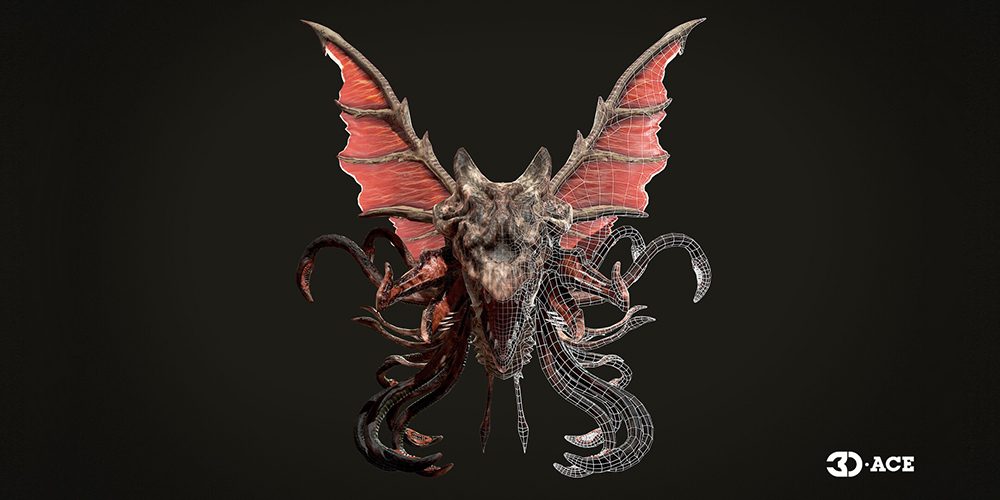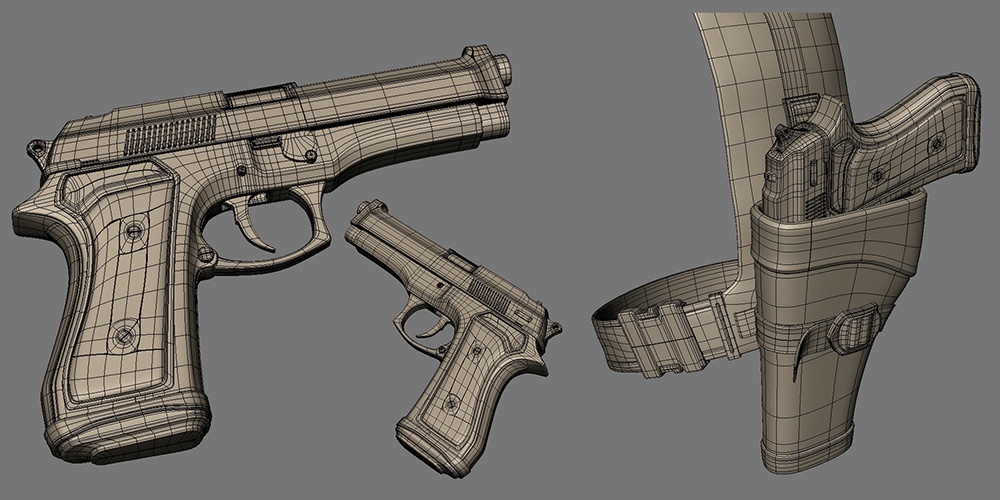Digital projects such as game development, animation design, and software architecting usually go hand-in-hand with 3D modeling. In turn, 3D models can be created in different ways to achieve flawless results and attract more users to a product.
There are two most popular ways of high-quality 3D modeling that are often compared — polygonal modeling vs. NURBS (spline) modeling. The end result of each method is quite similar, but the process and particularities are different for each.
So how does polygon and spline modeling work? Which is better to use and when? How can you find 3D modeling company whose expertise is perfect for this challenge? In this article, you’ll get all these answers. Let’s get started!
What is Polygon Modeling?
Polygonal modeling is one of the fundamental types of 3D modeling when specialists use triangles (tris) or polygons (poly) to build a complete three-dimensional model. What are polygons in 3D modeling? They are flat geometrical figures with at least 4 angles, which 3D artists use to form a model.
To be specific, these shapes are computer generated and connected to create a polygon mesh — a set of vertices and faces that form the individual features of a 3D object, and on a larger scale – the shape itself. You can picture it like a completed puzzle but in 3D graphics. The more detailed and accurate model specialists want to build, the more polygons they use. There are several polygon modeling techniques and tips that you can learn from the link.
Advantages and disadvantages of polygon modeling
There are some advantages in polygon vs. non-polygon modeling that are better to consider before starting the process.
Advantages:
- Polygonal models and their topology look more natural since each poly is designed individually and in detail.
- Many modes are assembled from complex components, so some of their separate polygons and tris can be edited or animated.
- Suitable for modeling characters, animals, objects, environments in games, animations, movies, etc.
- It is more frequently used in game development because it’s much more convenient for 3D modeling. Furthermore, most game engines (software for streamlined game development) are equipped with a specific toolbar for polygonal modeling.
Disadvantages:
- Polygon modeling can be very time-consuming in cases when 3D models require individual design and editing for each poly.
- Flat margins and polygonal meshes are hard to use for building a sharp-edged model suitable for industrial design.
What is Spline (NURBS) Modeling?
A spline is a curve in 3D space, technically referred to as a B-Spline (basis spline) that goes through at least two points. The full name of this type of simulation comes from NURBS, standing for Non-Uniform Rational Basis Spline. Imagine how you draw a cube: first, you need to calculate the correct distance between the faces, place the points along with the calculated distance, and connect these points with lines. Thus, you get a 3D figure.
So NURBS modeling is the process of working with splines — connecting them into a 3D cage, which forms a volumetric model of a particular shape. 3D artists use computer algorithms for setting NURBS geometry so that the final model looks proportional and natural.
There are two ways of working with this type of modeling — using NURBS curves and NURBS surfaces. Using curves implies creating surfaces from separate curves, which is better when you need to control the whole modeling process. On the other hand, you can simply create a future model surface and edit it for the required result.
Advantages and disadvantages of NURBS modeling
Let’s examine some key NURBS modeling advantages and disadvantages that help define its best use cases.
Advantages:
- Suitable for creating models with a smooth surface and accurate & detailed rendering of the appearance of models used to display architecture, engineering, or other industrial objects.
- The model’s surface created using NURBS modeling can be converted to a polygonal format if needed.
- This type of modeling is more accessible in editing models of any complexity since it is easier to change points’ position on the curve with an algorithm than to adjust the settings of the polygonal mesh vertices manually.
- There is no need to unwrap NURBS models like there is with polygonal models since the spline structure is similar to a UV map.
Disadvantages:
- It is difficult to edit, supplement, and detail individual parts of the model, as it requires a break in the structure, which affects the model’s final appearance.
- Game engines are much less adapted to NURBS modeling than polygonal modeling, as they are rarely used to create 3D game models.
Difference between Polygon and Spline Modeling
The main difference in polygonal modeling vs. NURBS lies in the materials 3D artists use and the purpose of modeling. Polygonal modeling is often used to create 3D game models or animations using separate tris and polys to develop a poly mesh. At the same time, NURBS modeling focuses more on creating detailed models for the visualization of products and natural objects.
For example, the 3D model below was created with polygonal modeling by 3D-Ace and published on ArtStation. As you can see, the model is made with a polygonal mesh that consists of evenly distributed polygons. After polygonal modeling, this model was finished with texturing responsible for the outer coating of the model and the natural effect. Our 3D artists used ZBrush and 3Ds Max software to achieve this result.

Below is a great example of a spline model made with Maya and accessible on ArtStation. We can view spline curves that intersect and form a spline cage in the shape of a pistol model.

Types of Modeling Software
As polygon and NURBS modeling types differ in the material used and the approach to creating models, some types of software are more adapted for specific purposes. Below, we examine the top applications for utilizing each of two modeling types — polygon and NURBS.
Top polygonal 3D modeling software
Polygon modeling in 3Ds Max is ideal for game models and animations, because polygon modeling is more common in game design. For example, the program has multiple useful tools for polygonal modeling such as vertex, edge, etc.
Blender is a free, open-source 3D model creation program for a wide range of purposes — creating 3D graphics, modeling, sculpting, and rendering. This is a professional resource that provides all the necessary functionality and a lot of training videos and documents on its use.
ZBrush
ZBrush is great for modeling smooth, photorealistic objects, although the program can only create meshes and not manipulate the poly separately. Use the Make PolyMesh3D tool and edit your model with the other tools – rendering, lighting, and more. You can also use the documentation for polygonal modeling.
Top NURBS modeling software
3Ds max in spline modeling can be helpful in both cases — modeling with a NURBS surface that requires a smooth design and for NURBS curves when you need to design models with sharp edges. The software provides its users with NURBS modeling documentation for more straightforward use.
Spline modeling in Maya is an opportunity to create models with curves and surfaces, as well as export NURBS 3D data with any CAD software. You can also use Maya to convert NURBS into polygons if you need a polygon-type cover in some samples. The software also provides a document for familiarization with NURBS modeling.
Since NURBS modeling is often used to create architectural or engineering models, it is easiest for professionals to use NURBS CAD (Computer-aided design) software such as AutoCAD. The principle of this program is in design automation, which saves designers time and increases the accuracy of work..
Entrust Your 3D Content to the Experts
Most of us have a great eye for detail, and easily notice how well a 3D model is thought out and executed, as well as how natural the objects look. Thus, it is always better to entrust such work to specialists with a high degree of 2D and 3D modeling expertise.
3D-Ace entirely fits the description of a highly qualified provider, except this is not one person but a whole team of experienced pros in the field of 3D development. Since 2009, we have completed hundreds of projects on 2D and 3D content modeling, design, and post-production. We take pride in helping clients around the world publish amazing content and achieve their business.
Our team is 100% ready to take on your project and see it through with top-notch quality. Contact us to discuss the details of your project and what you expect from it.









